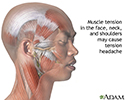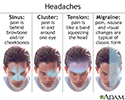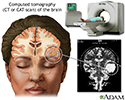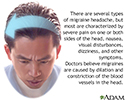Managing tension headaches at home
Tension-type headache - self-care; Muscle contraction headache - self-care; Headache - benign - self-care; Headache - tension- self-care; Chronic headaches - tension - self-care; Rebound headaches - tension - self-care
A tension headache is pain or discomfort in your head, scalp, or neck. Tension headache is a common type of headache. It can occur at any age, but is most common in teens and adults.
Tension headache
A tension headache is the most common type of headache. It is pain or discomfort in the head, scalp, or neck, and is often associated with muscle ti...

A tension headache occurs when neck and scalp muscles become tense, or contract. The muscle contractions can be a response to stress, depression, a head injury, or anxiety.
When you Have a Tension Headache
Hot or cold showers or baths may relieve a headache for some people. You may also want to rest in a quiet room with a cool cloth on your forehead.
Gently massaging your head and neck muscles may provide relief.
If your headaches are due to stress or anxiety, you may want to learn ways to relax.
Over-the-counter pain medicine, such as aspirin, ibuprofen, or acetaminophen, may relieve pain. If you are planning to take part in an activity that you know will trigger a headache, taking pain medicine beforehand may help.
Follow your health care provider's instructions about how to take your medicines. Rebound headaches are headaches that keep coming back. They can occur from overuse of pain medicine. If you take pain medicine more than 3 days a week on a regular basis, you can develop rebound headaches.
Be aware that aspirin and ibuprofen can irritate your stomach. If you take acetaminophen, DO NOT take more than a total of 3,000 mg a day to avoid liver damage.
Preventing Tension Headaches
Knowing your headache triggers can help you avoid situations that cause your headaches. A headache diary can help. When you get a headache, write down the following:
- Day and time the pain began
- What you ate and drank over the past 24 hours
- How much you slept
- What you were doing and where you were right before the pain started
- How long the headache lasted and what made it stop
Review your diary with your provider to identify triggers or a pattern to your headaches. This can help you and your provider create a treatment plan. Knowing your triggers can help you avoid them.
Lifestyle changes that may help include:
- Use a different pillow or change sleeping positions.
- Practice good posture when reading, working, or doing other activities.
- Exercise and stretch your back, neck, and shoulders often when typing, working on computers, or doing other close-up work.
- Get more vigorous exercise. This is exercise that gets your heart beating fast. (Check with your provider about what kind of exercise is best for you.)
- Have your eyes checked. If you have glasses, use them.
- Learn and practice stress management. Some people find relaxation exercises or meditation helpful.
If your provider prescribes medicines to prevent headaches or help with stress, follow instructions exactly on how to take them. Tell your provider about any side effects.
When to Call the Doctor
Call 911 if:
- You are experiencing "the worst headache of your life."
- You have speech, vision, or movement problems or loss of balance, especially if you have not had these symptoms with a headache before.
- A headache starts suddenly.
Schedule an appointment or call your provider if:
- Your headache pattern or pain changes.
- Treatments that once worked no longer help.
- You have side effects from your medicine.
- You are pregnant or could become pregnant. Some medicines should not be taken during pregnancy.
- You need to take pain medicines more than 3 days a week.
- Your headaches are more severe when lying down.
References
Freitag F. Managing and treating tension-type headache. Med Clin N Am . 2013;97(2):281-292. PMID: 23419626 www.ncbi.nlm.nih.gov/pubmed/23419626 .
Garza I, Schwedt TJ, Robertson CE, Smith JH. Headache and other craniofacial pain. In: Daroff RB, Jankovic J, Mazziotta JC, Pomeroy SL, eds. Bradley's Neurology in Clinical Practice . 7th ed. Philadelphia, PA: Elsevier Saunders; 2016:chap 103.
Schoenen J, Sava SL. Tension-type headache. In: McMahon SB, Koltzenburg M, Tracey I, Turk DC, eds. Wall and Melzack's Textbook of Pain . 6th ed. Philadelphia, PA: Elsevier Saunders; 2013:chap 59.
Silberstein SD. Headache management. In: Benzon HT, Rathmell JP, Wu CL, et al, eds. Practical Management of Pain . 5th ed. Philadelphia, PA: Elsevier Mosby; 2014:chap 30.
-
Tension-type headache - illustration
The most common cause of tension-type headaches is muscle contraction in the head, neck or shoulders.
Tension-type headache
illustration
-
Headache - illustration
Headaches are usually caused by either muscle tension, vascular problems, or both. Migraines are vascular in origin, and may be preceded by visual disturbances, loss of peripheral vision, and fatigue. Most headaches can be relieved or ameliorated by over-the-counter pain medications.
Headache
illustration
-
CT scan of the brain - illustration
A CT or CAT scan (computed tomography) is a much more sensitive imaging technique than x-ray, allowing high definition not only of the bony structures, but of the soft tissues. Clear images of organs such as the brain, muscles, joint structures, veins and arteries, as well as anomalies like tumors and hemorrhages may be obtained with or without the injection of contrasting dye.
CT scan of the brain
illustration
-
Migraine headache - illustration
Symptoms of a migraine attack may include heightened sensitivity to light and sound, nausea, auras (loss of vision in one eye or tunnel vision), difficulty of speech and intense pain predominating on one side of the head.
Migraine headache
illustration
-
Tension-type headache - illustration
The most common cause of tension-type headaches is muscle contraction in the head, neck or shoulders.
Tension-type headache
illustration
-
Headache - illustration
Headaches are usually caused by either muscle tension, vascular problems, or both. Migraines are vascular in origin, and may be preceded by visual disturbances, loss of peripheral vision, and fatigue. Most headaches can be relieved or ameliorated by over-the-counter pain medications.
Headache
illustration
-
CT scan of the brain - illustration
A CT or CAT scan (computed tomography) is a much more sensitive imaging technique than x-ray, allowing high definition not only of the bony structures, but of the soft tissues. Clear images of organs such as the brain, muscles, joint structures, veins and arteries, as well as anomalies like tumors and hemorrhages may be obtained with or without the injection of contrasting dye.
CT scan of the brain
illustration
-
Migraine headache - illustration
Symptoms of a migraine attack may include heightened sensitivity to light and sound, nausea, auras (loss of vision in one eye or tunnel vision), difficulty of speech and intense pain predominating on one side of the head.
Migraine headache
illustration
Review Date: 1/5/2016
Reviewed By: Joseph V. Campellone, MD, Division of Neurology, Cooper University Hospital, Camden, NJ. Review provided by VeriMed Healthcare Network. Also reviewed by David Zieve, MD, MHA, Isla Ogilvie, PhD, and the A.D.A.M. Editorial team.




